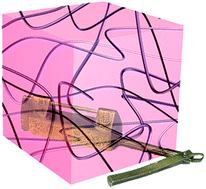Hydrogels locked by molecular recognition aiming at responsiveness and functionality
Abstract
The principle of molecular recognition originating from the concept of lock-and-key has been one of the foundation stones for modern chemistry and biology. Molecular recognition in either biomolecules or synthetic molecules leads to non-covalent linkages, which are featured by responsiveness, reversibility and competition, differing from the covalent bonds. Therefore, recently, this concept has been introduced to and employed in the field of functional materials with great success. In this review, these materials will be examined from the molecular recognition point of view, without considering the origins of the binding pairs involved. First, the structural characters of hydrogels locked by molecular recognition are discussed in detail with emphasis on the chemical structure and architectures of the interaction pairs and the corresponding


 Please wait while we load your content...
Please wait while we load your content...